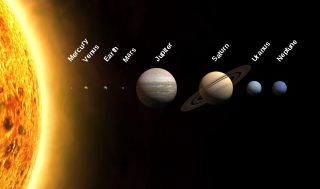Lesson Notes By Weeks and Term - Junior Secondary School 1
THE EARTH IN SPACE II
SUBJECT: BASIC SCIENCE
CLASS: JSS1
DATE:
TERM: 3RD TERM
REFERENCE
WEEK SEVEN AND EIGHT
THE EARTH IN SPACE
Man has been inquisitive about the sky, the moon and the stars for a very long time. Now, a lot has been known about the component of the universe and other celestial bodies.
THE SOLAR SYSTEM
The sun and all the bodies orbiting round it makes up the SOLAR SYSTEM. The planets and their moons are the main bodies that revolve round the sun.
Other bodies in the solar system are ASTEROIDS, COMETS, and METEROIDS.
THE PLANETS
Nearest to the sun is mercury, the smallest of the planets. Then come Venus, Earth, Mass, Jupiter[the biggest planet], Saturn, Uranus, Neptune, and Pluto. The distance across the solar system is about 12000million kilometres.
THE NINE PLANETS

EVALUATION
ROTATION AND REVOLUTION OF THE EARTH AND MOON
THE EARTH
The earth is the third planet from the sun and it is the only known planet in the universe that harbours living things. The earth contains water which in addition to the oxygen assists in supporting life on earth.
The earth does not produce light hence it is said to be non-luminous.
While those heavenly bodies that give out light, such as the stars and the sun are said to be luminous.
The earth has only one satellite called the moon. The moon revolves round the earth. The earth rotates about its axis giving rise to day and night.
THE SUN
The sun is the single biggest star in the universe that supplies all planets light and heat. The sun does not rotate. Earth revolves round the sun giving rise to seasons. The earth takes approximately 365 days to revolve round the sun. There is no water or atmosphere in the sun.
THE MOON
The moon is the only earth satellite that revolves round its axis. The moon gives a reflection of light from the sun and supplies the earth with moon light. The moon is non- luminous and has no life on it.
EVALUATION
DESCRIPTION OF ECLIPSE, CLIMATE, AND SEASONS
Eclipse of the sun; This occurs when the moon moves between the sun and the earth and all are exactly in a straight line.
Eclipse of the moon ; It occurs when the earth is between the sun and the moon and the three are exactly on a straight line.
NOTE: There is nothing like eclipse of the earth.
EVALUATION
CLIMATE AND SEASONS
Climate can be defined as the average weather condition of a particular area for a given period of time.
SEASONS
The REVOLVING of the earth about the sun gives rise to seasons.
Different parts of the surface of the earth have the sun shinning on them at different times of the year.
There is a time when there are shorter days and longer nights during some months in a year, and also shorter nights and longer days during some other months.
There are also some months during which the days and nights are equal in duration. This happens because the earth moves in an orbit around the sun. The earth tilts in opposite direction twice a year, hence, giving rise to two seasons –Rainy and Dry seasons.
DAY AND NIGHT
The sun supplies the earth warmth and light. The earth is spherical in shape. When the earth rotates about its axis round the sun, part of its surface is expose to sunlight while the rest remain in darkness. The part exposed to sunlight experiences DAY while the part in the darkness experiences NIGHTS.
EVALUATION
READING ASSIGNMENT
Precious seed BASIC SCIENCE FOR JUNIOR SECONDARY SCHOOLS BOOK 1 page 167-176
GENERAL EVALUATION
WEEKEND ASSIGNMENT
THEORY
© Lesson Notes All Rights Reserved 2023